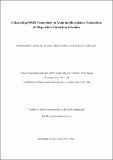Calculating NMR parameters in aluminophosphates : evaluation of dispersion correction schemes
View/
Date
02/2014Grant ID
EP/E041825/1
EP/J010510/1
EP/J501542/1
EP/J501542/1
EP/J501542/1
Keywords
Metadata
Show full item recordAbstract
Periodic density functional theory (DFT) calculations have recently emerged as a popular tool for assigning solid-state nuclear magnetic resonance (NMR) spectra. However, in order for the calculations to yield accurate results, accurate structural models are also required. In many cases the structural model (often derived from crystallographic diffraction) must be optimised (i.e., to an energy minimum) using DFT prior to the calculation of NMR parameters. However, DFT does not reproduce weak long-range "dispersion'' interactions well, and optimisation using some functionals can expand the crystallographic unit cell, particularly when dispersion interactions are important in defining the structure. Recently, dispersion-corrected DFT (DFT-D) has been extended to periodic calculations, to compensate for these missing interactions. Here, we investigate whether dispersion corrections are important for aluminophosphate zeolites (AlPOs) by comparing the structures optimised by DFT and DFT-D (using the PBE functional). For as-made AlPOs (containing cationic structure-directing agents (SDAs) and framework-bound anions) dispersion interactions appear to be important, with significant changes between the DFT and DFT-D unit cells. However, for calcined AlPOs, where the SDA-anion pairs are removed, dispersion interactions appear much less important, and the DFT and DFT-D unit cells are similar. We show that, while the different optimisation strategies yield similar calculated NMR parameters (providing that the atomic positions are optimised), the DFT-D optimisations provide structures in better agreement with the experimental diffraction measurements. Therefore, it appears that DFT-D calculations can, and should, be used for the optimisation of calcined and as-made AlPOs, in order to provide the closest agreement with all experimental measurements.
Citation
Sneddon , S , Dawson , D M , Pickard , C J & Ashbrook , S E 2014 , ' Calculating NMR parameters in aluminophosphates : evaluation of dispersion correction schemes ' , Physical Chemistry Chemical Physics , vol. 16 , no. 6 , pp. 2660-2673 . https://doi.org/10.1039/c3cp54123a
Publication
Physical Chemistry Chemical Physics
Status
Peer reviewed
ISSN
1463-9076Type
Journal article
Collections
Items in the St Andrews Research Repository are protected by copyright, with all rights reserved, unless otherwise indicated.
Related items
Showing items related by title, author, creator and subject.
-
Unusual intermolecular “through-space” J couplings in P–Se heterocycles
Sanz Camacho, Paula; Athukorala Arachchige, Kasun Sankalpa; Slawin, Alexandra Martha Zoya; Green, Timothy F.G.; Yates, Jonathan R.; Dawson, Daniel McLean; Woollins, J Derek; Ashbrook, Sharon Elizabeth (2015-05-20) - Journal articleSolid-state NMR spectra of new P–Se heterocycles based on peri-substituted naphthalene motifs show the presence of unusual J couplings between Se and P. These couplings are between atoms in adjacent molecules and occur ... -
Controlling the electromagnetic proximity effect by tuning the mixing between superconducting and ferromagnetic order
Stewart, R.; Flokstra, M. G.; Rogers, M.; Satchell, N.; Burnell, G.; Miller, D.; Luetkens, H.; Prokscha, T.; Suter, A.; Morenzoni, E.; Lee, S. L. (2019-07-12) - Journal articleWe present low-energy muon-spin rotation measurements on Cu/Nb/AlOx/Co thin films that probe the newly described electromagnetic (EM) proximity effect. By varying the thickness of the insulating AlOx layer we control the ... -
Switching on electrocatalytic activity in solid oxide cells
Myung, Jaeha; Neagu, Dragos; Miller, David N.; Irvine, John T. S. (2016-09-22) - Journal articleSolid oxide cells (SOCs) can operate with high efficiency in two ways—as fuel cells, oxidizing a fuel to produce electricity, and as electrolysis cells, electrolysing water to produce hydrogen and oxygen gases. Ideally, ...

